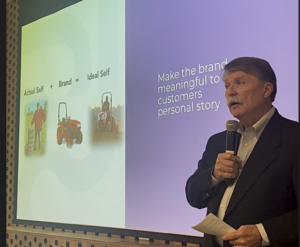Companies often forget that branding isn’t just an attractive logo or a catchy tagline for its clients—it is the foundation of their market positioning, financial health, and long-term viability. Yet, too often, they fail to align their brand and business strategies, leading to costly missteps.
That is why the Bloodhound Group (BHG), founded by Jim Cobb and Global Brand Strategist Ann Wilson, has taken a holistic approach to brand management. Since its establishment in 2017, the company has integrated neuroscience (psychology) and in-depth market research with its clients’ business strategy rather than just focusing on the aesthetics or messaging of the brand.
The main problem is that many businesses struggle meaningfully connecting with their customers. They either focus too much on product features without understanding the emotional drivers behind purchasing decisions or fail to align branding with business objectives. Cobb explains, “Most brands fail because they don’t understand something critical about their customers: their emotional connection to the product or service. Companies get caught up in talking about what their product does rather than why it matters to the customer.”
Wilson adds, “Other agencies focus on outputs such as ads, websites, and campaigns. We take a holistic view of a business, treating branding as an asset that directly impacts financial performance and long-term equity.”
Take, for example, a commercial water heater company that approached BHG to help launch a new product. Initially, the company’s marketing strategy emphasized its product’s cutting-edge features. However, this marketing consultancy firm uncovered a deeper emotional driver. Business owners feared losing an entire workday due to hot water failure, which could lead to significant revenue losses. By repositioning the product’s messaging to address this concern, BHG helped the company create a more compelling brand narrative.
What sets BHG apart is its ability to analyze brands from the inside out. Unlike traditional agencies that focus only on marketing output, the company works directly with C-suite executives, sales teams, and key stakeholders to ensure branding efforts are fully integrated into business strategy. This inside-out approach fosters internal accountability, preventing the common disconnect between marketing efforts and actual business impact. “You’d be surprised how often companies launch a brand without aligning their internal teams,” Cobb says. “We make sure that sales teams, leadership, and marketing all understand the brand’s objectives, so messaging is consistent, and there’s a clear pathway to revenue generation.”
BHG’s process begins with deep market research, identifying opportunities and potential roadblocks. The team uses neuroscience-based techniques to measure how people physically react to branding to help a company’s message truly resonate subconsciously.
Additionally, they employ storytelling and archetype-based branding to create authentic and emotionally compelling messages. “Ninety percent of decisions people make are emotionally driven,” Cobb notes. BHG uses scientific methods such as tracking physical reactions and emotional responses to identify people’s subconscious connections with brands.
“People can’t always articulate why they feel a certain way about a brand,” Cobb explains. “We measure their emotional responses to different branding elements, from colors to storytelling techniques, and we use archetypes to craft brand identities that resonate deeply.” This approach allows BHG to position brands in a way that taps into primal human instincts, creating stronger customer loyalty and more effective messaging.
Branding challenges don’t just affect large corporations—startups face unique hurdles. Many fail not because they lack a great idea but because they lack proper management and financial planning. BHG advises startups to have exemplary leadership to execute their vision and innovation. Even investors don’t just evaluate the market potential of a product; they also assess whether the leadership team can execute. “A great idea with bad management will fail. A great idea with strong management has a chance of success,” says Wilson.
For established businesses, the challenge is often staying ahead of rapidly shifting market dynamics. The rise of technology has led to shorter brand life cycles, making it crucial for companies to anticipate changes rather than react to them. BHG helps businesses navigate this uncertainty by identifying problems early before they become irreversible.
To future-proof a brand, its identity needs to be closely tied to the company’s business model and customer relationships. BHG supports businesses in developing brands that can perform well in a competitive market. According to the team at BHG, navigating this process requires persistence and insight. In a time when brand loyalty is more challenging to achieve, businesses benefit from a thoughtful, strategic approach to branding.
Media Contact
Name: Gwen Cox
Email: gcox@bloodhoundbranding.com
Published by Jeremy S.









